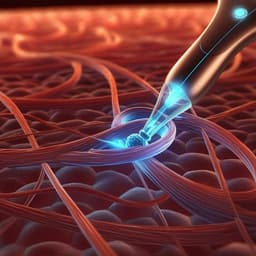
Health and Fitness
Wireless battery-free body sensor networks using near-field-enabled clothing
R. Lin, H. Kim, et al.
Discover how innovative near-field-enabled clothing can revolutionize the way we monitor human physiological signals. Conducted by a team of experts including Rongzhou Lin, Han-Joon Kim, and others from the National University of Singapore, this research showcases a unique system for real-time, battery-free sensor networks that can help enhance clinical diagnostics and athletic performance.
~3 min • Beginner • English
Introduction
The study addresses a central challenge in wearable health monitoring: enabling simultaneous, continuous, and comfortable acquisition of physiological signals from multiple body locations without wired tethers or rigid batteries. Conventional radio-based methods (e.g., Bluetooth, Wi-Fi) require per-sensor power sources, increasing bulk and reducing conformability, while NFC-based approaches enable battery-free operation but are limited to a few centimeters of range from the reader. The authors propose near-field-enabled clothing—textiles embroidered with conductive inductor patterns that act as relays to extend NFC power and data connectivity around the body—to create battery-free body sensor networks that operate over meter-scale separations while maintaining proximity security and compatibility with standard NFC devices.
Literature Review
Prior work shows wearable sensors can measure diverse physiological parameters but typically require wired connections or batteries for radio-based communication, limiting comfort and long-term usability. Radio methods raise privacy concerns due to radiative transmission requiring cryptography. NFC has emerged for battery-free skin-mounted/implantable sensors (heart rate, oximetry, sweat analytes, UV exposure), but is constrained by very short read ranges (<4 cm for mobile readers). Earlier multi-sensor demonstrations achieved mapping or neonatal monitoring by embedding large NFC readers into bedding, incompatible with upright or mobile use. Other recent approaches used stretchable passive tags but required per-sensor powered readout circuits integrated into clothing. Metamaterial textiles have also been explored for body sensor networks. In contrast, the present work uses fully fabric-based, passive, near-field relays integrated into clothing to extend NFC range without adding fragile electronics or connectors, maintaining compatibility with unmodified smartphones.
Methodology
Design concept: Near-field-enabled clothing integrate connected planar inductor patterns (relays) embroidered with conductive thread on conventional textiles. When a wireless NFC reader (13.56 MHz ISM band) is placed near a hub coil, time-varying currents are induced along the relay, creating magnetic hotspots at distal terminal coils to power and communicate with NFC sensor nodes beyond conventional NFC range.
Modeling and simulation: The system is modeled using circuit equivalents (reader inductor Q1, sensor inductor Q2, coupling coefficient k) and verified with full-wave electromagnetic simulations (CST Microwave Studio) at 13.56 MHz. Power transfer efficiency η (under ideal impedance matching) is evaluated versus lateral/vertical displacement, relay length, coil geometry, and misalignment. Simulations compare direct reader–sensor coupling and coupling via a 1 m relay; field amplitudes and η maps quantify hotspots and operating regions.
Materials and fabrication: Conductive thread (silver-plated polyamide yarn, σ ≈ 7.8 × 10^4 S/m) is embroidered using computer-controlled machines onto polyester-spandex or cotton-polyester garments. Connections are made with conductive epoxy and sealed with hot-melt glue. Threads are encapsulated in transparent thermoplastic polyurethane for robustness. Patterns include circular/rectangular coils and meandered interconnects; serpentine geometries provide up to 100% stretch without degrading transmission. Patterns are designed with parameters such as radius r, turns N, and wire gap g to optimize η for 13.56 MHz.
Relay and network design: A shirt network with a central hub and multiple terminals is implemented. Inductor designs (partial circular, rectangular, filled circular) tailor magnetic field distribution for increased operational area, vertical range, or directional displacement. Multi-terminal relays are interconnected in series or parallel; parallel networks offer robustness to disconnections while series provide higher η. Anti-collision and multi-tag reading are supported by a commercial NFC reader implementing ISO 15639 slotted ALOHA (16 slots).
Characterization: Wireless S-parameters and efficiencies are measured with a VNA and commercial NFC tag coils (3.1 cm diameter). Tests evaluate relay length dependence (10 cm to 3 m), misalignment tolerance, deformation over curved surfaces, and wetting effects. Smartphone-sized NFC antennas are used for practical validation.
Applications and human studies:
- Multi-node spinal posture monitoring: Three battery-free strain sensor nodes (NFC chipset + elastomeric resistive strain gauge, up to 100% strain, gauge factor ≈ 3) are mounted at cervical, thoracic, and lumbar regions and interconnected to a hub worn on the arm. Data are sampled at ~1 Hz using NFC multiplexing. Validation against camera-based motion capture with reflective markers assesses agreement.
- Continuous exercise monitoring: In a thermal chamber (28 °C, 70% RH), a shirt and pants with relays interconnect a battery-free axillary temperature node and a knee strain node to a smartphone hub. Protocol: (1) seated acclimatization (10 min), (2) treadmill walking/running at 2.8, 5, 7.2, 9 km/h (2 min each), (3) walking at 6 km/h (30 min). A battery-powered ankle gyroscope (104 Hz) provides reference for gait; smartphone records temperature at 4 Hz; NFC relay maintains connectivity during motion and perspiration.
Key Findings
- Range extension: A 1 m relay creates distal magnetic hotspots increasing field amplitude by ~5 orders of magnitude at the terminal; simulated peak η ≈ 30% at the hotspot and >10% within 1.5 cm lateral displacement. Without relay, η drops from ~70% (concentric) to ~1% at 5 cm lateral offset.
- Experimental validation: Using a smartphone-sized NFC antenna and an NFC sensor, measured η > 6% within 1.5 cm of the relay terminal; vertical operating distances remain a few centimeters, aiding physical-layer security.
- Relay length and loss: With conductive thread (σ ≈ 7.8×10^4 S/m), η ≈ 30% maintained from l = 10 cm to 1 m; η ≈ 6.3% at l = 3 m due to ohmic and transmission line effects.
- Mechanical robustness: Electrical performance varies <5% after >5000 bending cycles (≥1 mm radius) and after >200 h immersion at 70 °C. Serpentine interconnects enable up to 100% stretch without η degradation. Curvature and wetting change η by <2–3% in most configurations.
- Orientation sensitivity: NFC connection maintained up to angular misalignment θ ≈ 60°, with η decreasing by ~3×; body conformity helps alignment.
- Multi-terminal networks: Efficiency per terminal decreases approximately inversely with the number of terminals. For 6 parallel terminals, η to each node ≈ 3%, sufficient for reliable communication at 200 mW reader output. Maximum read height above terminals decreases from 4.5 cm (single) to 1.5 cm (six). Per-sensor sampling rate decreases from ~8 Hz (single) to ~1.3 Hz (six); total reader power unchanged.
- Spinal posture sensing: Distinct motions produce location-specific responses: cervical motion yields ΔR/R up to ~150% at S1; lower back motion yields up to ~60% at S2/S3; whole spine engages all sensors. Wireless strain closely matches wired measurements and correlates with camera-based cervical bending angle.
- Continuous temperature monitoring: During acclimatization, axillary temperature rises ~1.5 °C over ~6 min, followed by ~0.5 °C increase during walking; constant-speed walking shows <0.5 °C fluctuations. Continuous 40-min acquisition at 4 Hz without connectivity loss despite perspiration; calibration agrees closely with a wired thermocouple.
- Gait monitoring: Knee strain node yields stride time Δt closely matching ankle gyroscope (difference <1.5%). As speed increases 2.8→9 km/h, Δt decreases 0.98→0.65 s and STV decreases 2.10→1.74%. During 30-min walking at 6 km/h, STV remains <3% (strain sensor 2.58%, gyroscope 1.86%).
Discussion
The results demonstrate that passive, fabric-embedded near-field relays can transform short-range NFC into meter-scale, body-wide networks for powering and reading multiple battery-free sensors using standard NFC readers or smartphones. By shaping the magnetic field distribution via embroidered inductors, the clothing establishes spatially distributed hotspots enabling reliable energy and data transfer to skin-mounted sensors during daily motions and exercise, overcoming the fundamental range constraint of NFC. The approach maintains low profile, comfort, and physical-layer security due to near-field operation, and avoids fragile or wash-sensitive electronics by relying on passive textile patterns. Application-level demonstrations in posture tracking and exercise monitoring confirm practical utility and accuracy compared to gold standards (motion capture, gyroscope), while multi-node operation leverages standard anti-collision protocols. Compared to systems relying on per-node batteries or bulky harvesters, this architecture centralizes power at a single hub and reduces cost and maintenance. Compared to conventional e-textiles embedding active circuits, the passive, NFC-compatible design enhances robustness and usability.
Conclusion
This work introduces near-field-enabled clothing that extends NFC connectivity from a few centimeters to meter-scale across the body, enabling networks of lightweight, battery-free sensors for continuous physiological monitoring. The fully fabric-based, embroidered inductive relays are robust, stretchable, and compatible with unmodified smartphones. Demonstrations include multi-node spinal posture sensing and continuous temperature and gait monitoring during exercise, with validated accuracy and uninterrupted connectivity. Future research should expand sensor modalities (e.g., electrophysiology, oximetry, respiration, sweat analysis), scale to larger sensor counts requiring higher data rates and more efficient multiplexing, and improve sensor-node materials and reliability over intended lifetimes. Aesthetic integration (e.g., colored threads, invisible patterns) and further optimization of relay geometries may enhance user acceptance and performance.
Limitations
- Near-field constraint: Vertical operating distance remains limited to a few centimeters; connectivity requires proximity to embroidered patterns.
- Orientation sensitivity: Performance degrades with angular misalignment; although mitigated by garment conformity, orientation matters.
- Multi-node trade-offs: Adding terminals reduces per-terminal efficiency, operating height, and per-sensor sampling rate due to energy and time-slot sharing.
- Ohmic and transmission losses: Efficiency decreases with relay length (notably beyond ~1 m) due to conductive thread losses.
- Sensor characteristics: Elastomeric strain sensors exhibit hysteresis; additional circuitry/signal processing may be needed for dynamic accuracy.
- System scalability and validation: Larger sensor networks will demand improved multiplexing/data rates and need long-term reliability validation for disposable/extended use. Material conductivity in unconventional sensors may limit robust wireless operation.
- Power source dependency: Operation requires a powered hub (e.g., smartphone) positioned near the relay hub.
Related Publications
Explore these studies to deepen your understanding of the subject.







